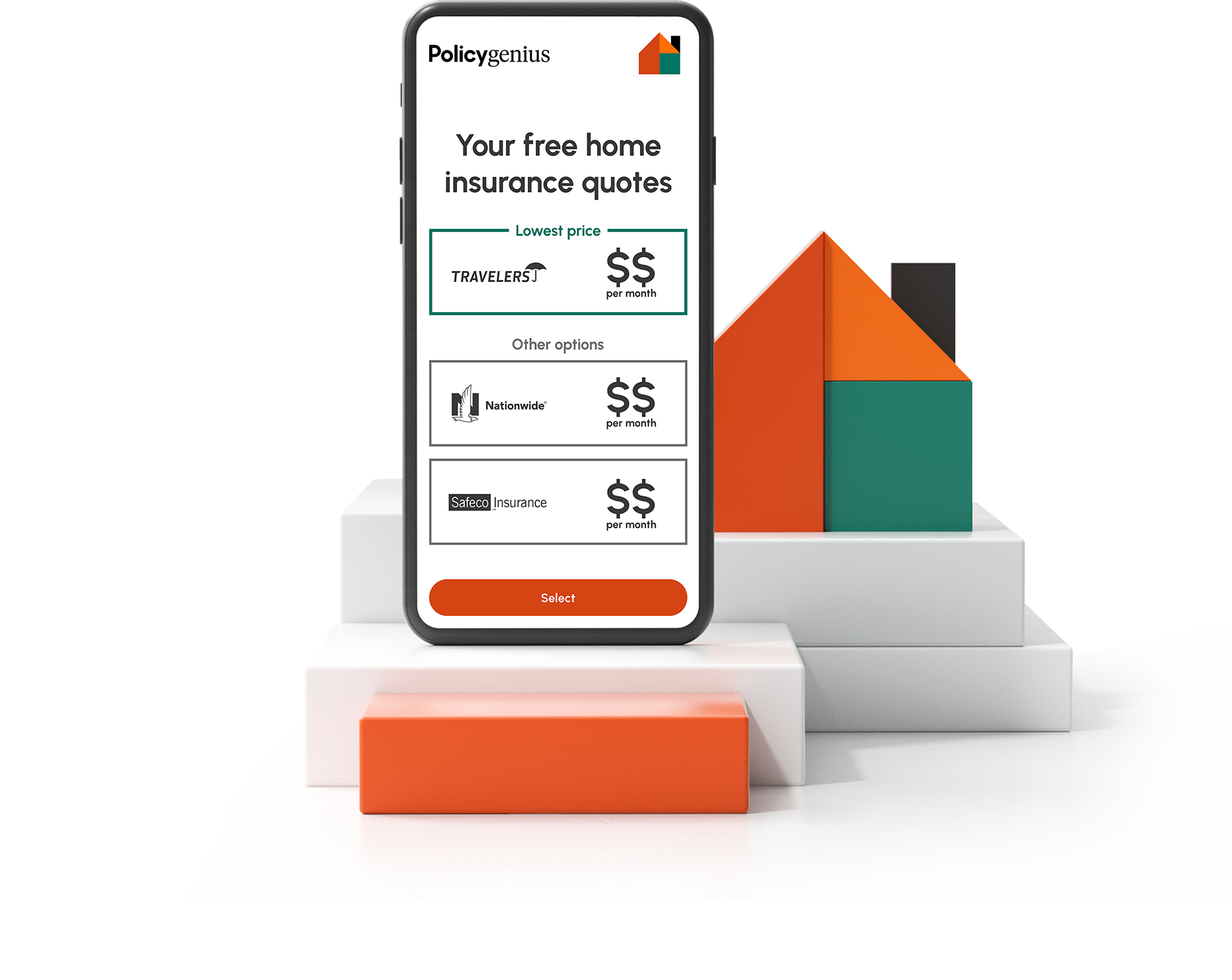What is the best way to shop for homeowners insurance?
The best way to shop for homeowners insurance is by comparing quotes through an insurance marketplace like Policygenius or through an independent agent who sells policies from multiple different companies.
When comparison shopping, you can quickly find out which company offers the cheapest quotes for a specific amount of coverage, or which one offers the best deal on different amounts of coverage.
Where to shop for homeowners insurance
Whether you're interested in purchasing home insurance from a broker or a particular company, you can often get quotes online, in person, or by calling an agent.
Online through the insurer's website or mobile app
By calling a local agent who sells policies through one or multiple companies
By going to a company's or independent agent's local office
Online through an independent insurance marketplace like Policygenius
Here's our step-by-guide to shopping for home insurance.
How to buy homeowners insurance
Compare home insurance quotes from multiple companies to find the best deal on the right policy for your needs. With Policygenius, you can do this in a matter of minutes. Simply answer a few brief questions about your property, and our licensed agents will provide you with personalized coverage options at a price that works for your budget.
To help you make an informed comparison between companies and quotes, we put together a brief list of steps to take when buying homeowners insurance.
1. Learn about how much coverage you need
The first step to shopping for homeowners insurance is calculating how much coverage you need. When you get home insurance quotes, the coverage amounts listed are often estimates — not an exact calculation of coverage you need. To make sure you’re being quoted for the right amount of coverage, consider getting a more accurate estimate of the following:
The replacement cost of your home: The amount of insurance on your house should be equal to its replacement cost — the amount it would cost to rebuild the home from the ground up after a disaster. Insurers often provide their own replacement cost estimate using online estimation tools, but for a more precise calculation, consider hiring a professional appraiser.
The total value of your personal belongings: You’ll want enough personal property coverage to cover the value of all of your stuff, like appliances, furniture, and electronics.
The total value of all of your assets: You should have enough personal liability coverage to cover your entire net worth in case you’re sued.
Your homeowners insurance coverage needs will also depend on your home’s location and the risks (wildfires, hurricanes, tornadoes) where you live. If you live in a high-risk coastal area or region that experiences frequent wildfires, your coverage needs will be different than if you lived somewhere with a more mild climate.
Learn more >> How to calculate homeowners insurance
2. Get familiar with home insurance policy lingo
There are six types of coverages that are in every standard homeowners insurance policy. Understanding how you’re protected by each of the coverage types in a standard policy will be useful when comparing policies.
Dwelling: Covers physical damage to the structure of your home and any attached structures, like a garage or porch
Other structures: Covers physical damage to structures on your property that aren’t attached to the home itself, like a detached garage, guest house, or fencing around your property
Personal property: Covers damage or theft of personal belongings that you own, including furniture, clothes, jewelry, and electronics
Additional living expenses (ALE): If your home is severely damaged or destroyed by a peril covered by your home insurance policy, ALE can cover the cost of temporary lodging and relocation expenses while your house is being repaired or rebuilt
Personal liability: Covers you and your assets from expensive lawsuits if you’re ever held liable for someone else’s injury or property damage
Medical payments: Covers guests’ medical expenses if they’re injured on your property
You’ll also have to choose between three levels of coverage:
Actual cash value: The cheapest option, actual cash value reimburses you for the value of your property minus the cost of depreciation, or wear and tear. This leaves you paying more out of pocket when you file a claim.
Replacement cost value: Most insurers allow you to upgrade to replacement cost value coverage, which reimburses you for the value of your property at today’s prices. This provides larger reimbursements when you file a claim.
Extended replacement cost value: Another optional upgrade, extended replacement cost value coverage reimburses you for the cost to rebuild your home — even if it’s more than your policy limit. This protects you from construction material and labor costs that tend to skyrocket after a natural disaster.
Learn more >> Types of home insurance coverages
3. Gather information about your home
To get an accurate quote estimate, you’ll need to give the insurer information about yourself and the type of property you’re insuring.
Here’s some of what you’ll need to provide when you shop homeowners insurance policies.
Your home’s square footage and roof type (like hip or gable)
The heating type of your home’s appliances (gas or electric)
The renovation history of your home
Whether you have any pets, trampolines, or a pool
Whether it's your primary or second home
Whether you rent it out in the short or long term
The more details you give about your home, the more accurate your quote will be. If you’re simply swapping out policies, most of this information will be available on your old policy. Otherwise, you can find your home’s structural details by searching for your property on your county’s property appraiser website.
4. Compare home insurance quotes
The easiest way to buy homeowners insurance is through an online insurance marketplace like Policygenius where you can compare quotes across multiple companies in your area. Once you apply, a licensed expert will reach out with policy recommendations that match your coverage needs and budget.
Apart from looking at coverage amounts and rates, it's also worth researching the company itself. Sites like AM Best provide information about each insurance company's financial strength and stability, while J.D. Power and Consumer Reports offer granular insight into the quality of an insurer's customer service or coverage.
5. Choose your policy & deductible level
Once you've compared quotes and feel good about a particular option, it's time to select a policy. Keep in mind that when you buy home insurance, you're not locked into the contract — in fact, you can change home insurance companies at any point during the policy period.
Once you've picked a policy, it's time to finalize a few details.
Choose a deductible. You’ll have to decide on a home insurance policy deductible, which is the amount you’re responsible for paying on each claim before the insurance company reimburses you. Choosing a high deductible will lower your premium, but you'll have to contribute more to each claim you make.
Determine how your premiums are paid. It's common practice for lenders to require that premiums for the year be paid in full ahead of closing on your mortgage. If insurance and property taxes are paid through an escrow account set up by your lender, this payment will likely be part of your mortgage closing costs.
Set your policy dates. Lastly, you’ll choose your policy period, which is when your home insurance starts and ends. If you’re switching homeowners insurance providers, a Policygenius agent can cancel your old policy, set an effective date for your new one, and inform your loan officer of the switch.
Once your billing and policy details are set and your lender approves of the policy, you’re good to sign on the dotted line, pay your first premium, and activate your homeowners insurance. At this point, you'll receive your homeowners insurance declarations page that lists out basic details about your policy and coverage amounts.
Shop homeowners insurance locally
As you shop for homeowners insurance, you'll want to consider your home's location risk and understand how it impacts your coverage needs.
A homeowner living in tornado-prone area, for example, may want to only consider insurance carriers that offer extended or guaranteed home rebuild coverage as a policy option; or carriers that have multi-policy bundling discounts that can help lower your home and auto insurance rates.
Choose your state from the dropdown below to find the best companies, average costs by local area, and better understand what type of insurance you need where you live.
Shop the best home insurance companies
Policygenius has comprehensive reviews of over 25 home insurance companies, including claim satisfaction rankings from companies like J.D. Power and Consumer Reports.
Below are some of the best homeowners insurance companies rated by Policygenius for a variety of shoppers, including those looking for more affordable rates, discounts for first-time homebuyers, and more.
Company | Policygenius rating | Best for |
|---|---|---|
5.0 out of 5 | Overall | |
4.9 out of 5 | Military families | |
4.8 out of 5 | Widely available coverage | |
4.6 out of 5 | Customer service | |
4.6 out of 5 | High-value homes | |
4.5 out of 5 | Lapse in coverage | |
4.5 out of 5 | Customizable policy options | |
4.5 out of 5 | Comprehensive dwelling coverage | |
4.5 out of 5 | Discounts and policy perks | |
4.5 out of 5 | Easy claims filing | |
4.4 out of 5 | Bad credit | |
4.4 out of 5 | Home sharing | |
4.3 out of 5 | New homeowners | |
4.3 out of 5 | Smart home insurance | |
4.2 out of 5 | High-risk homes | |
Neptune | Not rated | Private flood insurance |
Learn more >> Best homeowners insurance companies in 2024
How to get homeowners insurance after being dropped
Your insurance provider can cancel or nonrenew your policy for any number of reasons. For example, perhaps the insurer nonrenewed your policy because you made too many claims, or maybe your policy was abruptly canceled in the days or weeks after you were initially approved because you failed your insurance inspection.
Here's a few steps to shopping for homeowners insurance if you've been dropped by your provider.
Contact the insurance company. Contact your insurer and see if anything can be done to keep your policy. For example, if your policy was canceled or nonrenewed due to reports of brushfires in your area, you may be able to maintain your coverage if you hire someone to create a defensible space around your property or install nonflammable home siding or roofing.
Consider surplus lines insurance. Surplus lines insurance has become an increasingly popular coverage option for homeowners in disaster-prone areas, as these policies are generally designed for high-risk homes that aren't eligible for standard home insurance coverage. One thing to keep in mind is that surplus lines policies aren't financially backed by state guarantee associations, which means if disaster strikes and the carrier doesn't have the money to pay out every claim, the state won't step in to cover the unpaid losses. While the likelihood of something like this happening is generally low, it's something to consider when choosing a company and policy.
Contact your state's FAIR Plan. FAIR Plans are a form of last-resort home insurance coverage that typically come with high premiums and minimal protection compared to a normal policy, but are a necessary stopgap in avoiding a lapse in coverage. If you’re unable to find home insurance coverage because of your home’s risk or other factors, a FAIR Plan is a dependable fallback option while you shop for longer-term solutions.
If your policy is nonrenewed at the end of its term, you'll typically have anywhere from 30 to 60 days to find a replacement. If your home insurance is canceled at the beginning or middle of your term, most companies will give about two weeks to a month notice — though this can vary based on the company and the insurance laws in your state.
What factors impact the price of homeowners insurance?
The average cost of home insurance is $1,754 per year, or around $146 a month. Your home insurance premium is directly tied to your likelihood of filing a claim. That’s why the age of your home and location play a pivotal role in how much you pay each month. For example, you’re more likely to file a claim if your home is older or you live in an area prone to flooding, which typically equals higher rates.
Here are a few other factors insurance companies consider when deciding your premium:
Claims history. If you have multiple insurance claims on your record in the past five years, insurers will think you’re more likely to file a claim, which spells higher rates.
Home’s building materials. Your home’s building construction, roof type, heating type, and the condition of your home all play a role in your insurance premiums.
Credit score. Insurers look at your credit score when determining your rate. Statistically, people with a lower insurance score are more likely to file a claim.
Neighborhood crime rate. If you live in an area prone to break-ins or vandalism, you’ll see higher rates to match that higher risk.
Owning a pool, trampoline, or dogs. Most insurance companies charge higher premiums if you have a pool, if you have a trampoline, and even if you have certain dog breeds since your home poses a greater risk of accidents happening.
The average cost of homeowners insurance is $1,754 per year for $300,000 in dwelling coverage, according to our analysis of home insurance rates from across the country.
Below are how different factors can raise that rate.
High-risk factor | Average annual cost | Percentage difference from national average |
|---|---|---|
Aggressive dog | $1,986 | 4.58% |
Pool | $2,002 | 5.42% |
Poor credit | $3,645 | 91.94% |
1 claim | $2,101 | 10.64% |
3 claims | $2,916 | 53.55% |
5 claims | $4,407 | 132.07% |
75-year-old home | $1,931 | 1.69% |
100+ -year-old home | $1,956 | 3.00% |
20-year-old roof | $1,913 | 0.74% |


